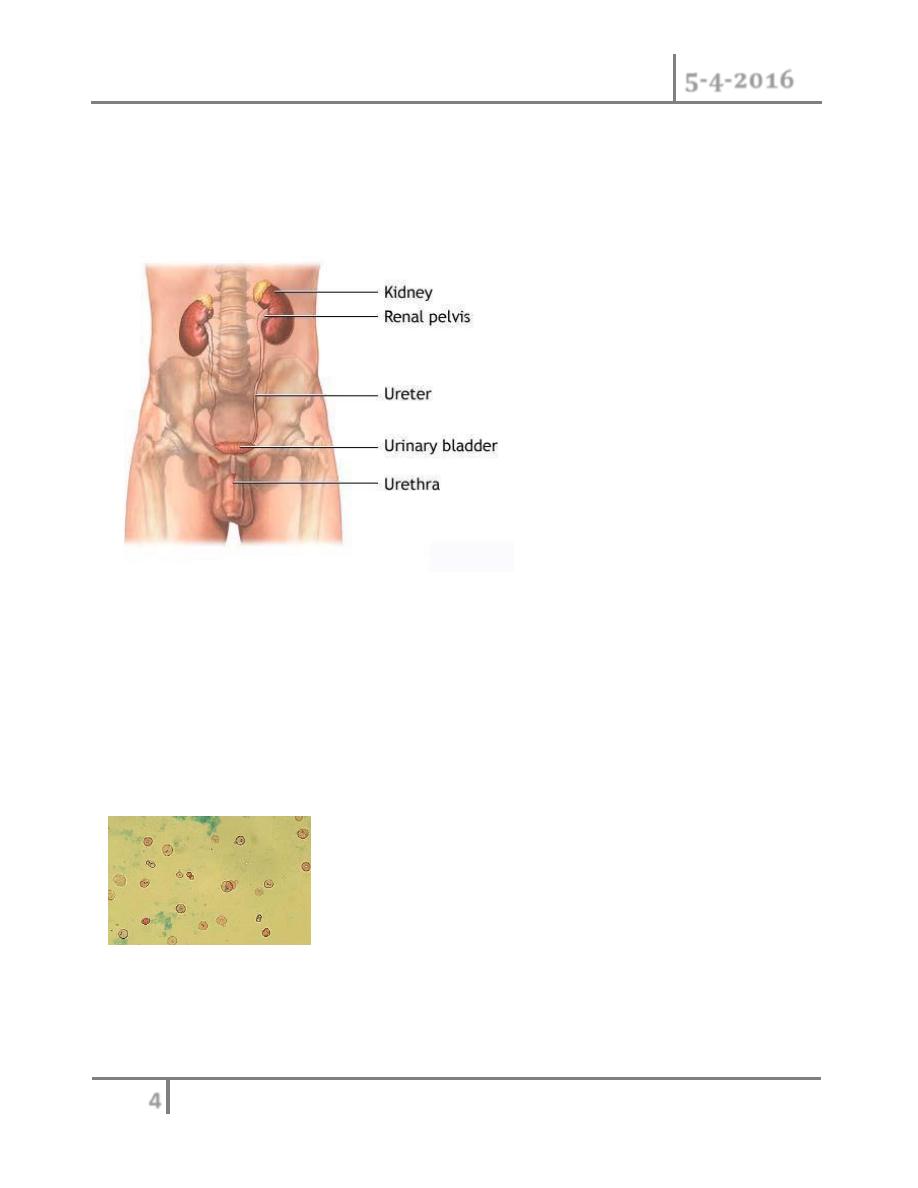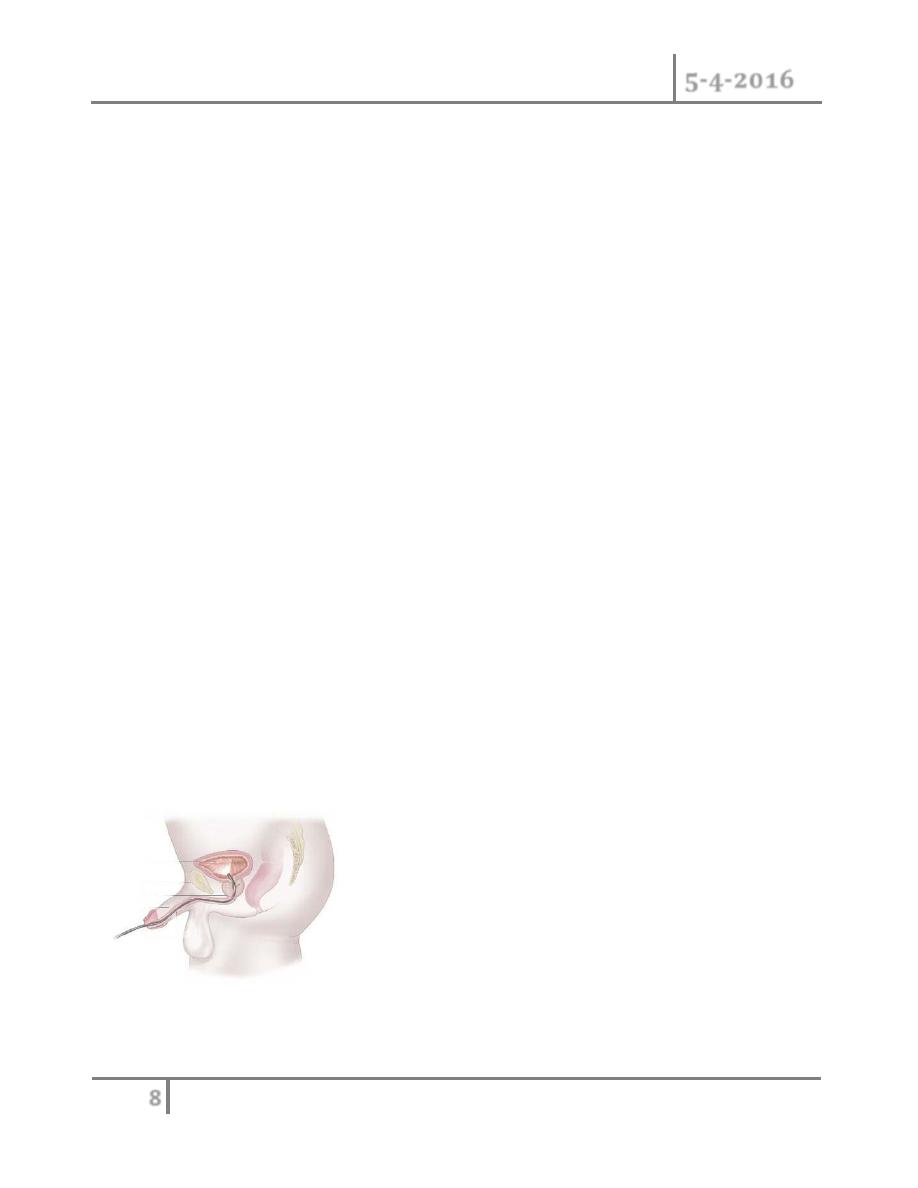
Baghdad College of Medicine / 4
th
grade
Student’s Name :
Dr. Saad Dakhil
Lec. 3
BLADDER CANCER
Tues. 5 / 4 / 2016
DONE BY : Ali Kareem
مكتب اشور لالستنساخ
2015 – 2016

Bladder Cancer Dr. Saad Dakhil
5-4-2016
2
©Ali Kareem 2015-2016
M
ODULE
5: H
EMATURIA
K
EY
W
ORDS
: Hematuria, Cystoscopy, Urine Cytology, UTI, bladder cancer
L
EARNING
O
BJECTIVES
At the end of this clerkship, the learner will be able to:
1. Define microscopic hematuria.
2. Describe the proper technique for performing microscopic urinalysis.
3. Identify four risk factors that increase the likelihood of finding malignancy
during evaluation of microhematuria.
4. Explain the significance of finding red cell casts in patients with microscopic
hematuria.
5. Contrast the evaluation of hematuria in the low risk patient with that of high-
risk patient.
6. Identify the indications for screening urinalyses in the general population.
D
EFINITION
Hematuria is defined as the presence of red blood cells in the urine. When visible to
the patient, it is termed gross hematuria and is usually alarming to patients.
Microscopic hematuria is that detected by the dipstick method or microscopic
examination of the urinary sediment.
The dipstick method to detect hematuria depends on the ability of hemoglobin to
oxidize a chromogen indicator with the degree of the indicator color change
proportional to the degree of hematuria
(http://www.auanet.org/eforms/elearning/core/?topic=24#s1). Dipsticks have a
sensitivity of 95% and a specificity of 75% and positive results should be confirmed
with a microscopic examination of the urine. Free hemoglobin, myoglobin and certain
antiseptic solutions (povidone-iodine) will also give positive readings. Knowing the
serum myoglobin level and results of the microscopic urinalysis will help differentiate
these confounders. The presence of significant proteinuria (2+ or greater) suggests a
nephrologic origin for hematuria.
Microscopic examination of urine is performed on 10 mL of a midstream, clean-catch
specimen that has been centrifuged for 10 minutes at 2000 rpm. The sediment is
resuspended and examined under high power magnification. With this method,
microscopic hematuria is defined as > 3 red blood cells per high-powered field
(rbc/hpf) on two of three specimens.

Bladder Cancer Dr. Saad Dakhil
5-4-2016
3
©Ali Kareem 2015-2016
Figure 1: Red blood cells observed on high power microscopy of urine
sediment.
The presence of red cell casts, dysmorphic red blood cells, leukocytes, bacteria and
crystals should also be included in the report.
E
PIDEMIOLOGY
The prevalence of microscopic hematuria ranges from 1-20% depending on the
population studied. The likelihood of finding significant urologic disease in these
patients also varies with associated risk factors which include:
Even though the likelihood of documenting a urologic malignancy in patients referred
for microscopic hematuria is approximately 10%, no major health organization
currently recommends routine screening for microhematuria in asymptomatic
patients. Instead, the decision to obtain a urinalysis (dipstick or microscopic) is based
on the interpretation of clinical findings by the evaluating physician.
Table 1 – Risk Factors for Hematuria
Age >40 years
Male gender
History of cigarette smoking
History of chemical exposure (cyclophosphamide, benzenes, aromatic amines)
History of pelvic radiation
Irritative voiding symptoms (urgency, frequency, dysuria)
Prior urologic disease or treatment

Bladder Cancer Dr. Saad Dakhil
5-4-2016
4
©Ali Kareem 2015-2016
E
TIOLOGY
The source of red blood cells in the urine can be from anywhere in the urinary tract
between the kidney glomerulus and the urethral meatus (Figure 2).
Figure 2: Human urinary tract anatomy that
is at risk when hematuria is found. From:
Nlm.nih.gov
Causes of hematuria may be
generally grouped into the site of
origin: Glomerular or Nonglomerular. Glomerular causes generally arise from the
kidney itself. Nonglomerular etiologies can be further subdivided by whether the
process is located in the upper urinary tract (kidney and ureter) or lower urinary tract
(bladder and urethra) (Figure 2). In general, urologists are concerned with structural
and pathologic conditions that are visible on imaging and endoscopic examination
whereas glomerular hematuria is the purview of nephrologists.
Urinary findings suggestive of a glomerular source for the patient’s hematuria include
red cell casts, dysmorphic red blood cells (Figure 3) and significant proteinuria.
Figure 3: Example of dysmorphic red blood cells consistent with renal or
glomerular hematuria.

Bladder Cancer Dr. Saad Dakhil
5-4-2016
5
©Ali Kareem 2015-2016
The presence of red cell casts in the urinary sediment is strong evidence for
glomerular hematuria.
Figure 4: Example of a red cell cast (arrow) in the urinary sediment.
Although protein may enter the urine along with the red blood cells regardless of the
origin of the hematuria, significant proteinuria (>1,000 mg/24 hours) likely indicates a
renal parenchymal process and should prompt consultation with a nephrologist. The
more common causes of glomerular hematuria are listed in Table 2. A more
comprehensive list is found in references 2 and 4.
Berger’s disease is the most common cause of asymptomatic glomerular
microhematuria and, in the absence of significant proteinuria, typically follows a
benign course. There is no proven treatment for the condition although fish oils may
benefit patients with progressive disease.
Causes of non-glomerular hematuria are often classified by location. The more
commonly encountered upper and lower urinary tract etiologies are listed in Table 3.
Although transitional cell carcinoma involving the urinary bladder is the most common
malignancy discovered in patients with asymptomatic microhematuria, a benign
process is far more the more likely explanation for the problem. In particular, urinary
tract infection, urinary tract stones and prostatic enlargement occur more frequently
than urologic malignancies.
Table 2 – Common Causes of Glomerular Hematuria
IgA nephropathy (Berger’s disease)
Thin glomerular basement membrane disease
Hereditary nephritis (Alport’s syndrome)

Bladder Cancer Dr. Saad Dakhil
5-4-2016
6
©Ali Kareem 2015-2016
Excessive anticoagulation from oral anticoagulation therapy does not lead to de novo
hematuria. However, the degree and duration of hematuria from another cause may
be influenced by such therapy.
E
VALUATION
The cornerstone of evaluating patients with hematuria is a thorough medical history
and directed physical examination. A prior history of urologic disease or interventions
is an important feature. Also, the presence of flank pain, fever or urinary symptoms
such as dysuria, frequency and urgency should be noted
(http://www.auanet.org/eforms/elearning/core/?topic=67#DIAGNOSIS AND
STAGING). Association with other activities (menses, physical exertion, etc.) may
suggest an etiology for the patient’s hematuria. Pelvic irradiation and certain
chemotherapeutic agents, in particular cyclophosphamide and mitotane, have been
associated with hemorrhagic cystitis. Both cigarette smoking and occupational
exposures to aniline dyes and aromatic amines used in certain manufacturing
processes increase the risk of bladder cancer.
The presence of edema and cardiac arrhythmias may suggest the nephrotic syndrome
Table 3 – Common Causes of Non-Glomerular Hematuria
Upper Tract
Urolithiasis
Pyelonephritis
Renal cell cancer
(http://www.auanet.org/eforms/elearning/core/?topic=48#s4)
Transitional cell carcinoma
(http://www.auanet.org/eforms/elearning/core/?topic=45)
Urinary obstruction
Benign hematuria
Lower Tract
Bacterial cystitis (UTI)
Benign prostatic hyperplasia
Strenuous exercise (“marathon runner’s hematuria”)
Transitional cell carcinoma
Spurious hematuria (e.g. menses)
Instrumentation
Benign hematuria

Bladder Cancer Dr. Saad Dakhil
5-4-2016
7
©Ali Kareem 2015-2016
and atrial fibrillation (with the possibility of renal embolization), respectively.
Costovertebral angle tenderness is suggestive of ureteral obstruction, often secondary

Bladder Cancer Dr. Saad Dakhil
5-4-2016
8
©Ali Kareem 2015-2016
to stone disease, in the afebrile patient. When fever and flank tenderness are both
present the diagnosis of pyelonephritis should be entertained.
If the patient has not had a formal microscopic urinalysis this should also be part of
the initial evaluation
(http://www.auanet.org/eforms/elearning/core/?topic=24#s1)
. As
noted earlier, the dipstick urinalysis may yield false-positive results in patients with
myoglobinuria. Also, some patients may present with “red urine” relating to dietary
intake or medication use (phenazopyridine) and these cases of spurious hematuria
may reveal a normal urinalysis. Understand, however, that hematuria may be
intermittent in patients with significant urologic disease and a repeat urinalysis
should be obtained if clinical suspicion is present.
In addition to identifying the number of red blood cells per high-powered field, the
presence or absence of red cell casts and/or dysmorphic red blood cells, the presence
of white blood cells and bacteria in the urinalysis may suggest infection. If infection is
suspected, a confirmatory urine culture should be obtained and a repeat urinalysis
performed after the infection has been treated. Patients with findings consistent with
glomerular hematuria should be referred to nephrology for further evaluation.
Based on the history and physical examination, including the urinalysis, patients with
nonglomerular hematuria may be stratified as high risk or low risk for significant
underlying urologic disease. Patients with gross hematuria or those with any of the
risk factors noted in Table 1 are considered high risk and should undergo a thorough
urologic evaluation. Patients with asymptomatic hematuria and no associated risk
factors are classified as low risk.
Because of the significant diseases that can cause nonglomerular hematuria, a
complete evaluation of the urinary tract is indicated. Imaging studies are used to
evaluate the upper urinary tract (kidneys and ureters) whereas urine cytology or
direct endoscopic visualization of the bladder and urethra are needed for the lower
urinary tract (Figure 5). The diagnostic studies selected depend on the risk factors for
significant disease.-
Figure 5: Flexible cystoscopy is used to examine the lower urinary tract in
patients with hematuria.
In low risk patients, renal ultrasonography and voided urine cytology are appropriate screening
studies for hematuria
(http://www.auanet.org/eforms/elearning/core/?topic=65#s3)
. Ultrasound

Bladder Cancer Dr. Saad Dakhil
5-4-2016
9
©Ali Kareem 2015-2016
examination of the kidneys will detect and characterize renal masses larger than 1 cm in
diameter.

Bladder Cancer Dr. Saad Dakhil
5-4-2016
10
©Ali Kareem 2015-2016
Also, clinically significant nephrolithiasis is likely to be found by ultrasound. Although
the ureters are difficult to image with ultrasonography, proximal hydronephrosis
(dilation) or unilateral absence of a “ureteral jet” of urine into the bladder suggest
ureteral obstruction and the need for additional studies. Cytologic examination of a
voided urine specimen is helpful to detect urothelial cancer
(http://www.auanet.org/eforms/elearning/core/?topic=65#s3)
. Remember that urine
cytology does not screen for renal cell cancer (a reason for renal imaging) and may
reveal false negatives in the case of low-grade transitional cell cancers. Conversely,
positive urine cytology is usually indicative of transitional cell cancer and follow-up
endoscopic examination is necessary for a definitive diagnosis, and for localization
and staging. Low-risk patients may prefer to proceed directly to cystoscopy, which is
acceptable.
Patients with gross hematuria or associated risk factors should undergo contrast-
enhanced imaging of the kidneys and ureters in addition to cystourethroscopy and urine
cytology
(http://www.auanet.org/eforms/elearning/core/?topic=45#s3)
Previously, the intravenous pyelogram (IVP) was the standard upper tract imaging
study for hematuria. However, this has been largely replaced by computerized
tomography (CT) scanning of the abdomen and pelvis after administration of
intravenous contrast
(http://www.auanet.org/eforms/elearning/core/?topic=62#s4)
. CT
scanning is superior in differentiating cystic from solid masses within the kidney
compared to the IVP. Significant information about non-urologic structures is also
provided on CT imaging. Non-contrast helical CT scanning of the abdomen and pelvis
is now the method of choice for detecting renal calculi. Before ordering any contrast
study (IVP or contrast-enhanced CT scan), the patient’s medications and allergies
should be reviewed and normal renal function documented.
If imaging studies suggest calyceal or ureteral pathology, then cystoscopic
examination may be performed in the operating room where retrograde ureterograms
can be done under fluoroscopic guidance. If imaging studies are normal, then
cystoscopy is performed in the office with topical anesthesia. At the time of
cystoscopy, a “bladder wash” (barbotage) can be sent for cytology, as the yield from
this test is higher than that of a voided urine specimen.
With this evaluation strategy, a cause for hematuria is identified in over 80% of cases.
Depending on their risk, up to 20% of patients with asymptomatic microhematuria are
discovered to have a urologic cancer. Patients with persistent hematuria after a
negative initial evaluation warrant repeat evaluation at 48-72 months since 3% of this
group will be subsequently diagnosed with a urologic malignancy. Despite these
findings, please remember that there are no evidence-based recommendations for
screening asymptomatic patients for hematuria.

R
EFERENCES
Asymptomatic Microscopic Hematuria in Adults: Summary of the AUA Best
Practice Policy Recommendations, Grossfeld GD, Wolf JS, Litwin MS, Hricak H,
Shuler CL, Agerter DC, Carroll PR, American Family Physician, 2001, 63 (6)
accessed May 7, 2011: http://www.aafp.org/afp/2001/0315/p1145.html
Evaluation of the patient with hematuria, Yun EJ, Meng MV, Carroll PR,
Medical Clinics of North America, 2004, 88 (2)
Evaluation of hematuria in adults, Rose BD, Fletcher RH, UpToDate,
2007 Campbell-Walsh Urology, 9
th
edition, WB Saunders; 2007,
pages 97-100
Updated June, 2012
END OF THIS LECTURE …
